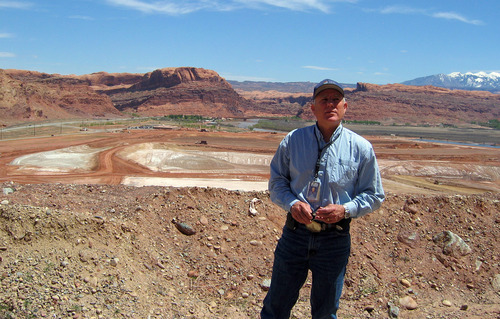This is an archived article that was published on sltrib.com in 2012, and information in the article may be outdated. It is provided only for personal research purposes and may not be reprinted.
Cleanup crews have hauled a big chunk of the massive Atlas tailings pile away from Moab during the past three years. But the project's supporters now worry about the heavy lifting ahead: the political effort needed to keep the project moving.
Under a new contract just getting under way, about 3 million tons of uranium-processing waste is set to be moved during the next five years. That's a significant slowdown from the 5 million tons carved out of the 16-million-ton pile during the past three years.
And Rep. Jim Matheson, D-Utah, has raised concerns that the Energy Department will be a decade off its congressionally mandated deadline for completing the job by 2019.
Matheson has championed moving the tailings from the banks of the Colorado River in recent years, just like former Sen. Bob Bennett, R-Utah, did before he was ousted in a tea party wave that swept the Utah GOP two years ago.
But Matheson is now running for the new 4th Congressional District, and the tailings project will be in the redrawn 3rd Congressional District next year, where Republican Rep. Jason Chaffetz is running for re-election and is favored to win.
And although Utah GOP Sen. Mike Lee returns to the Senate next year along with Orrin Hatch, assuming he wins re-election, Moab Mayor Dave Sakrison has not heard what the lawmakers plan to do on behalf of the tailings cleanup. He's also concerned about a slowdown.
"It would be nice to have some congressional help on this thing besides from Jim," said the mayor.
Portage Inc., which won the Energy Department's five-year, $121.2 million cleanup contract for the work, has announced workers will move the tailings in shifts of 10 hours a day, four days a week, nine months a year.
Last week Matheson wrote to Energy Secretary Steven Chu on the pace and cost-effectiveness of the agency's current strategy for the cleanup. He noted that the job won't be done until 2029 at the current rate. He also pointed out that about 25 percent of the funding will be spent on Energy Department overhead.
"An important characteristic of the Moab project is that there is an end in sight, and I believe an aggressive effort to complete the removal will be a more fiscally prudent use of taxpayer funds," Matheson wrote in the April 25 letter. "In other words, fixed administrative costs take place year after year but if more funds go into actual tailings removal, it will take fewer years to complete the project and total administrative costs will be less."
Chaffetz said Thursday he is "100 percent committed to accelerating" the cleanup. But he noted that the district is currently Matheson's, so his efforts to bring attention to the project have been behind the scenes so far.
"It's a must-do project," Chaffetz said. "The sooner we can finish this and put it behind us, the better."
More than a decade ago, Matheson and Bennett led the charge to get the Energy Department to take over the 130-acre site, a toxic eyesore across the highway from Arches National Park, in the aftermath of Atlas Corp.'s bankruptcy.
EnergySolutions Inc. built a cell about 30 miles north of the tailings and was responsible for moving the first 5 million tons of tailings from the banks of the Colorado, where the uranium-tainted tailings and other chemicals were leaching into the water source used by more than 25 million people.
Last month, after the General Accountability Office reviewed the contract award, EnergySolutions lost its appeal of the contract loss to Portage.





